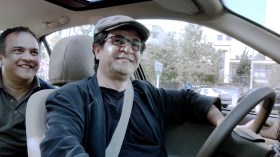Writing a review of Robert Egger’s (brilliant) Nosferatu is impossible without contextualising it among all vampire stories over the last century.
It was thanks to Bram Stroker’s novel Dracula that we got mainstream vampire tales – and it was the same novel that inspired the German silent film Nosferatu (FW Murnau, 1922) and birthed the instantly recognisable vampire look: fangs, pale skin, long black cloak.
Despite altering character and place names from the original Dracula, Murnau and the production team were sued for copyright infringement by Bram Stoker’s estate and all copies of the film were sent to be destroyed. But Nosferatu proved to be as unkillable as its namesake when a few surviving copies were later discovered and restored.
Now, after several Dracula adaptations and a hefty amount of vampires being interviewed, hunted and/or romanced on film later, we have come full circle to Egger’s Nosferatu (2025), an extremely faithful remake of that groundbreaking work of expressionism that utilises Egger’s unique understanding of the horror genre to make vampires scary again.
It’s also been over 100 years since the original, so copyright lawyers can put down the proverbial stakes.
As in the original, Nosferatu starts with the mysterious Count Orlok (Bill Skarsgård) summoning the young real-estate lawyer Thomas Hutter (Nicholas Hoult) to his remote castle in the Carpathian mountains. His request seems simple at first: he only wishes to buy a house in the town Hutter and his boss Knock reside in … except, of course, he wants so much more than that.
Meanwhile, Hutter’s wife, Ellen (Lily-Rose Depp), is wracked with a mysterious illness that causes her to have eerie and dreadful visions of a man warning her of his imminent arrival.
It was pretty clear after his films The Witch, The Lighthouse and The Northman that Robert Eggers was emerging as a modern horror auteur. Each of these films have such a clear, well-executed style, usually incorporating protagonists facing some kind of folk-loric madness, or existential threat that manifests as a beast, and presented in washed-out colour pallettes with deep, dark shadows (or in the case of The Lighthouse, completely shot on black and white film).
If you weren’t convinced of his mastery before, Nosferatu is the film that will change that.
ScreenHub: Conclave film review: pope opera sizzles with pontificate pulp
Like those previous films, much of the stunning aesthetic is thanks to cinematographer Jarin Blaschke. A number of shots in this film made me gasp with delight, primarily the birds-eye tracking shot over the town as the shadow of Orlock’s hand stretches out over the rooftops in the moonlight. While obvious in its metaphor, it is nonetheless a sumptuous visual.
The other standout is the wide-shot in the forest as Hutter approaches the hike up to Orlock’s castle. Alone and without a horse, Hutter stands shivering on a snowy crossroads among black pines. The depths of the inky darkness contrast so beautifully with the silvery snow, and all at once we too feel Hutter’s bone-deep fear.

Composer Robin Carolan, who had only composed for one feature film previously (The Northman), also deserves a shout-out for creating a deliciously dread-filled (and not dreadful) score. The orchestral stings will electrocute you as much as the jump-scares will (and yes, there are many).
Nicholaus Hoult, Willem Dafoe and the almost unrecognisable Bill Skarsgård are all in top form here, delivering the words of Eggers’ script with convincing skill – a task that can’t be easy, given the heightened, flowery language Eggers prefers. The script greatly benefits from the cast leaning heavily into the melodrama of it all, producing a tight group of performances that are incredibly faithful to the original film.
Many have praised Lily-Rose Depp for her performance, too, but I’m afraid I am an outlier in my opinion. I found her too disengaged with the role of Ellen Hutter, and I was largely unconvinced by her acting. It brought my impression of the film down a few notches, since her role is now central to the text. Orlock’s primary goal, after all, is finding her and presumably turning her into a vampire too so he can live out his trad-wife fantasies.
The story of Nosferatu is a complicated one. Nosferatu (the name by which Orlock is known in the story’s folklore) is not only a threat due to his blood-sucking nature, but also because he intends to steal wives away and give everyone else the plague.
It’s easy to see how that tapped into fears from the time it was originally made. The original Dracula was a thinly veiled anti-Semitic text, and so too was Murnau’s film adaptation. Outside of that it is a metaphor for general xenophobia, as it drew from fears surrounding mass immigration of Eastern Europeans.
But in Eggers’ remake, the story provides something of a warning about sexual repression, and the fast and tempting rise of fascism. No guesses as to why that take is relevant now.
Nosferatu is in cinemas from 1 January 2025.
Actors:
Lily-Rose Depp, Nicholas Hoult, Bill Skarsgård, Willem Dafoe
Director:
Robert Eggers
Format: Movie
Country: USA
Release: 01 January 2024





